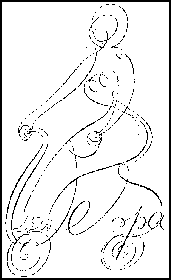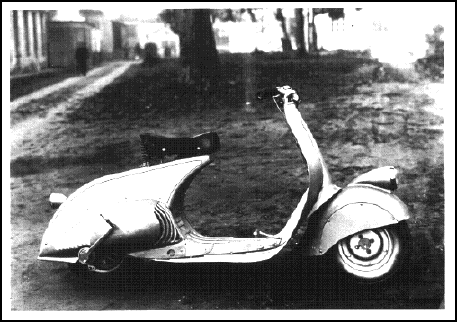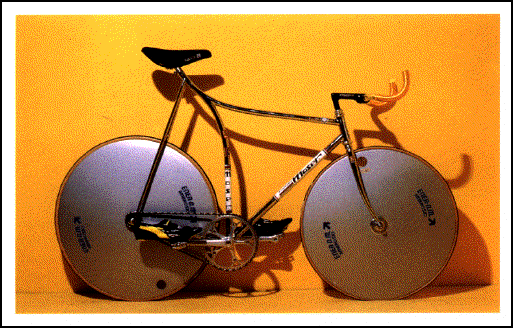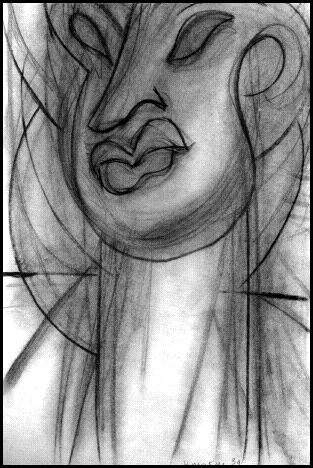E. L. Doctorow
Christopher D Morris,
Editor
(University Press of Mississippi)
A hundred years ago, a good writer was free of such an army of intellectual locusts. Emily Dickinson could hide out in the upper floors in her white dress, and none of these Amer. Lit. types would be rapping on her door. Nabokov handled it by giving no interviews whatsoever, preferring to pen answers to questions presented in a civilized way --- by mail. For all we know, maybe Hart Crane dove off that boat from Cuba just to get away from some frantic M.A. candidate trying for an inside scoop on his sex life for his oral at UC Berkeley.
Be that as it may, this Doctorow comes across as a saint, putting up with interviews from every literary peddler on the planet --- in this case, twenty-two of them, ranging from a hack on assignment for Publishers Weekly to a boor from Budapest, Hungary, with stentorian questions like,
You majored in philosophy at Kenyon College. To what extent has your training in philosophy helped shape you as a writer?
Despite this onslaught of noodling, Doctorow turns out some fine answers --- always patient, always ready to repeat himself (endlessly), often brilliant, often witty, often self-deprecating, and, every now and again, gently chastising. When some klutz from Heidelberg talks about "the sexual preoccupations" of "Jewish-American writers," Doctorow replies with grace, citing Wilhelm Reich, and closing with the lines, "You have here a particular responsibility to distinguish literary criticism from demonology."
What Conversations with E. L. Doctorow turns out to be, most of all, is a primer for would-be writers. Despite his protestations of innocence, this author lets us in on the mystery of the writing life. One interviewer asks him about the research he did on Julius and Ethel Rosenberg, for The Book of Daniel: Once I get going, I find myself looking things up, but not in any systematic way. At a certain point, I think, when your mind is organized and you're attuned to whatever your subconscious is doing, you become a kind of magnet for your own experiences and reading, and things in the air become relevant. On the basis of that, you're led from one thing to another. You see a picture in a newspaper, or you're walking through some stacks in a library and you see a title of a book, and in some peculiar, mystical way, things just happen to come up when you need them. Someone will tell you a story at a dinner party or you'll catch sight of a scene on a street corner, and it will become appropriate to the book. The ongoing book or the creative process, I think, generates a certain kind of energy in the writer which makes him a kind of selective magnet for things in his environment. That's what I would call research.
In all, we are left with a picture of Doctorow as a literate, irreverent, thoughtful soul --- and a fine conversationalist, with such lines as, I realized I was, like Hawthorne, not an exemplar of realism but a writer of romances. I was interested in imagery as a kind of moral data. Or quoting Freud, who said "America is a mistake, a gigantic mistake," I think it's funny to speak of anything that gigantic as 'a mistake.' Or there's the moment when he says to the pesky questioner from Heidelberg,
You think because I'm wearing a coat and tie, that I'm normal and middle-class? --- Actually, I am an actor employed by Doctorow to represent him.
He's tolerant, he's funny --- and he's a dandy story-teller:
I have a fantasy about The New York Times and this is what it is: that on a day when Tony Lewis' column is not scheduled to appear, The New York Times is published --- distributed to all of us --- and I have written it all. If I could get Punch Sulzberger to agree to issue the paper as written in its entirety by me, on just one day, I would spend many, many years preparing that particular city edition. And I would consider it --- it would be my life's work.
Style
Forms of
Creativity
Omar Calabrese, Editor
(Skira)
 In this lush 235 page volume, we are presented with ten different aspects of modern Italian fashion --- in the broadest sense --- ranging from cars and scooters to books, architecture, expresso-makers, and, weirdly enough, gardens. It's a strange hodge-podge, somehow melding The Name of the Rose with furniture design and the Fiat 500.
In this lush 235 page volume, we are presented with ten different aspects of modern Italian fashion --- in the broadest sense --- ranging from cars and scooters to books, architecture, expresso-makers, and, weirdly enough, gardens. It's a strange hodge-podge, somehow melding The Name of the Rose with furniture design and the Fiat 500.What editor Calabrese is trying to tell us, we would guess, is that it all comes out of the same pot --- namely Italian aesthetics (though we are damned if we can find much in common between the Ferrari Spider sports car and Marco Zanuso's design for the common table fork).
This isn't to say that there aren't some interesting points that turn up, like mushrooms in the hothouse, here or there. That, for instance, the design of churches and cathedrals has changed drastically as a result of Vatican II --- when it was no longer possible for the priest to face away from the congregation; and a whole new design and layout of religious interiors has thereby come into being. Or: the omnipresent Vespa scooter was created immediately after WWII because the company --- Piaggo --- decided that making warplanes was, perhaps, no longer an appropriate way to make a living (the company had been practically destroyed by American bombers).
 A German scooter --- one that had been used by paratroopers --- was found in a wreck, and it became the prototype of a transport that was practical and easy to drive, easy to handle, inexpensive, and easy to repair. The Vespa ("Wasp") was born and was an immediate success.
A German scooter --- one that had been used by paratroopers --- was found in a wreck, and it became the prototype of a transport that was practical and easy to drive, easy to handle, inexpensive, and easy to repair. The Vespa ("Wasp") was born and was an immediate success.
Italian Design, gives us lucious and generally excellent shots of gardens and cars and scooters and models, but the narrative that accompanies these pictures is lunky, to say the least --- and the spelling is quite odd. Listen:
Objects like the Ferrari are items of extreme pretence. In other design products this pretence can be masked in the free logic of form, in poetic licence of the artist, in the ethics of modern planning, but in the Ferrari it is naked...It shows its greatness and, of course, its deep-set roots: which do not refer to the bond between form and objects, that critical theories would like to divide giving an advantage either to the ethics of the aesthetics or social forms; rather, they refer to the historic contents of modern art and its effect on mass society.
It is as if the editor has said to his (barely) English-speaking translator --- "Look, we've got to fill up all this space between the photographs. Say anything you want, but, for God's sakes, fill up the page. And, since this is a book of multiple artistic forms, you should feel free to make up any words or spellings that you may care to." If you want convincing, consider this, from "From the Ritual of the Expresso-Maker to the Myth of the Mobile Phone:"
The looks of objects is often twinkling, provocative, aggressive yet alluring, depending on the ways they will meet the user. It is an event that is repeated countless times in the space of a day, in different instants and places, according to how we divide up our time into different activities. The intermediary between person and object is its use, which decrees the life of objects and products and which brings them to life...By focusing observation on the pattern of Italian life, we notice that the activities making up the day take place with specific rhythms, features and cadence, in the relationship between place of work, the home, the street, and so on.
But in such a rococo setting, with several hundred excellent color and black-and-white photographs, should we even care about mere words? For example, the views of the prototype Vespas are a dilly. The garden walks (one called "Love's Pathway") are dandy. The fashion models are exquisite --- famished, and --- in that sly Italian style --- half-woman, half-boy. Most of the architecture and furniture is ho-hum, but the designer Albini's models are a gas, and Francesco Mosser's bicycle is a knockout.

Of Alexandra
David-Neel
A Biography of the
Explorer of Tibet and
Its Forbidden Practices
Barbara and Michael Foster
(The Overlook Press)
A Fairy Tale for
Consenting Adults
Stephen Mitchell
(Harmony/Random House)
 A truly empathetic critic will go deep inside a work, hear the music, feel the soul-yearning that blossoms as poetry, fiction, non-fiction, art. I was married for ten years to a professional reviewer on the San Francisco Chronicle, and let me tell you that such empathy is rare. It's rare in life in general, alas --- and even more rare in critics. When he, finally, quit in disgust, he heard loud lamentations about the other critics from at least fifty artists and musicians in the area.
A truly empathetic critic will go deep inside a work, hear the music, feel the soul-yearning that blossoms as poetry, fiction, non-fiction, art. I was married for ten years to a professional reviewer on the San Francisco Chronicle, and let me tell you that such empathy is rare. It's rare in life in general, alas --- and even more rare in critics. When he, finally, quit in disgust, he heard loud lamentations about the other critics from at least fifty artists and musicians in the area.
Most often, reviews are a playing field for the critic's own name-dropping, sarcasm, or erudition. "I think I'll quote Euripides, Rabelais, and the Tao Te Ching," the reviewer may say. Or, he or she may write, "I went to kindergarten with Elizabeth Taylor, Babe Ruth used to practice throws with me, I did futures with Hilary Clinton, and I had sex with the great Wilhem Reich." All designed to raise a little envy.
We often wonder what criteria makes one book get that stamp of approval from the New York Times --- a stamp that guarantees success. My few youthful months as publicity person at Random House opened my eyes to the manifold, often willful powers, of the publishing corporations.
In the meantime, let me tell you that there are two books that have engaged me lately, tearing me away from the vast pulsing, global brain of cyberspace. The first is The Secret Lives of Alexandra David-Neel. It tells the story of a middle-aged woman whose adventures in the deep snows of the Himalayas, whose intricate enmeshment in the machinations of British, Tibetan, and Chinese foreign policy are as amazing as any work of fiction. She died at 108 --- which is some sort of magic number (it's the number of beads in a Tibetan mala.)
In the old Summer-of-Love days (which seem to have ended just yesterday) it was her first book, The Secret Oral Teachings of Tibet, that opened me to the intrinsic teachings of Tibetan Buddhism --- excuse me if I offend a few people --- whose rituals always remind me of the Catholic Mass.
For this book, and her teachings, I honor her in my heart. She learned her discipline sitting at the feet of a Buddhist master through two biting winters in a little shack, high in the Himalayas. Her teacher gave her the task of disseminating this essential information to the Western world.
I trudged with the aging Alexandra through thousands of miles of journeys and adventures, drinking bottomless cups of Tibetan tea. I literally got ill with the flu with her. I sat in awe as she finally beholds the shining towers of Lhasa, the first Western woman to do so --- speaking fluent Tibetan, disguised as a pilgrim because both the British and Tibetans want her gone.
And with her I complained, as I actually do, about the illnesses of old age. This brilliant dynamic woman has been twice now a spiritual guide for me, transmitting the best of Tibetan Buddhist wisdom. With all her human frailties, her spiritual and daring strength inspires me. Had she been a man, she would be revered in the Buddhist hierarchy.
I thank the Fosters for bringing her to me again, and hope you will trudge with her through her many years of both internal and external exploration. However, beware: I've loaned this book to two people and neither of them got it.
The other book is a totally enchanting, poetic, humorous, spiritual, deep, light and entrancing work of the poet Stephen Mitchell. It's called The Frog Prince, A Fairy Tale for Consenting Adults.
It is really a deliciously sweet analogy of the pain we put ourselves through as we let go of the old forms and put on new ones. As the old song went, Or would you rather be a frog?
I think it was Emily Dickinson who wrote some lines in "I'm nobody, who are you?" about the frog croaking its name the live-long day to an admiring bog. Obviously, she never tried kissing one --- so she never got to enjoy the metamorphoses that could have been hers.
As a poet, I love the woven lace of Mitchell's words. As a woman married three times and with many lovers in between times, I certainly appreciate the search for a frog who becomes a prince. Or the reality of a prince who "may very well, in the course of ordinary marriage, gradually, at first imperceptibly, turn into a frog." It certainly happens. Too often.
Stephen Mitchell's book is precious like a rare butterfly, a fable for the awakening heart.
Although the RALPH editor also sent me the new Rolling Stone book on beatniks, I won't name-drop today about beatniks I have known and loved. For that, you can see my book, which you'll also know and love --- The Scrapbook of a Haight Ashbury Pilgrim. You can order it from Pro-Mind Books, at http://www.promind.com.
Maybe some other time I'll drop names and astound you --- about (say) smoking pot with Lenny Bruce --- but right now the Monarch butterflies just came back from their 3,000 mile journey to wherever it is they go. Their orange and black beauty beats fragile against the fall marigolds and I've got to go out and watch. Instead of sitting around and reading this nonsense, you might consider doing the same.
Finally, may Editor --- let all the avatars and saints, Hindu Catholic, Buddhist and Moslem bless him --- continue to send me books that I can trade in at Logos. His generosity definitely carries him one major step towards a heaven where he will eternally review infinite fabulous books printed on golden parchment.
Ms. Gips' Homepage is at "Changes,"
which is hidden inside the letter-box below.
If you click on it, several frogs, butterflies
(and perhaps Elizabeth herself)
will pop out.


